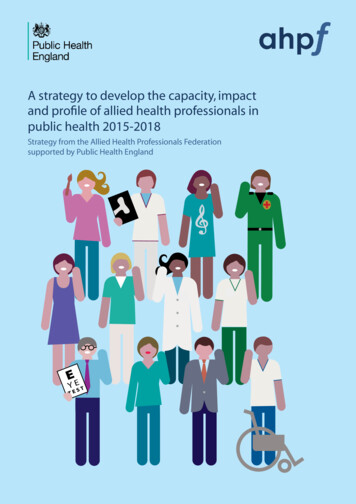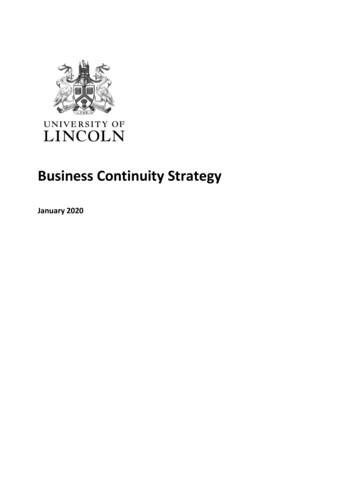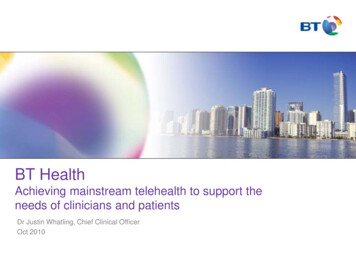
Transcription
A strategy to develop the capacity, impactand profile of allied health professionals inpublic health 2015-2018Strategy from the Allied Health Professionals Federationsupported by Public Health England
IntroductionThis joint strategy was produced by the Allied Health Professions Federation (AHPF) with the supportof Public Health England (PHE). It sets out our vision for the role of allied health professionals (AHPs) inpublic health. It details how we intend to implement that strategy, the goals we have set out to achieveand how we will measure our success.It is intended to help AHPs, as well as their professional bodies and partner organisations, to furtherdevelop their leadership in public health, share best practice with colleagues and partners and ultimatelyembed preventative healthcare across all their work.Strategic contextIn April 2014, the allied health professions (AHPS) agreed a collective ambition to be recognised as anintegral part of the public health workforce. Since then we have developed our public health contributionand profile and have seen some excellent examples of AHP-led public health initiatives across the lifecourse, from falls prevention for older adults to helping children to have the best start in life. We nowneed to maintain this momentum and spread good practice throughout our professions so that ourapproach to public health becomes our core way of working for the future.Recent policy documents such as the NHS England Five-Year Forward View and Public Health England’s(PHE) Evidence into Action highlight the national imperative to focus on a preventative approach toachieve improved population health and well-being, as well as minimise long term demand for servicesand ensure health and social care costs remain affordable. They also demonstrate the vital role thatprevention has to play in tackling widening health inequalities.Reports by the Centre for Workforce Intelligence and Royal Society for Public Health have highlightedthat AHPs have the enthusiasm, expertise and opportunity to make a significant difference to health andwellbeing over the next few years. AHPs are proud to be early adopters of the preventative approachand have an opportunity to work with other early adopter colleagues such as fire and rescue services,community pharmacy teams, midwives and the housing sector to further develop our contribution byaddressing public health issues across the system.This strategy has been developed jointly by the AHP Federation, the representative group of the 12 AHPprofessional bodies and PHE. There has been wide engagement with the 12 professional bodies andwider partner organisations and stakeholders as part of this work.Who are the AHPs?The AHPs include 12 professions regulated by the Health and CareProfessions Council (HCPC), which collectively make up the thirdlargest workforce in the NHS. They work across a range of sectorsincluding health, social care, education, academia, voluntary andprivate sectors across the life course. The 12 professions includephysiotherapists, occupational therapists, podiatrists, dietitians, speechand language therapists, paramedics, radiographers, orthoptists,prosthetists and orthotists, art therapists, music therapists anddramatherapists.
Definition of public health for AHPsPublic health is the science and art of promoting and protecting health and well-being, preventing illhealth and prolonging life through the organised efforts of society1. AHPs contribute to this through theirwork on physical, mental and social health with individuals, communities and populations across the 4domains of public health (Figure 1). Our actions contribute to primary, secondary and tertiary prevention.Figure 1 AHP contributions across the 4 domains of public healthNote: this figure is intended to provide examples of some of the ways AHPs can contribute to publichealth across the 4 domains rather than an exhaustive list of examples Screening programmeInfection controlAppropriate use of antibioticsRadiation protection Infuencing strategy Promoting healthy environments Access to education andemployment Supporting antsHealth carepublic healthHealthimprovment Early diagnosis andinterventions Supporting self management Rehabilitation and enablement Management of chronic conditions Falls prevention Making every contact count Health improvement campaigns Occupational health ergonomics Community development programmes1. Faculty of public health
The AHP public health visionOur vision is for AHPs to be recognised as an integral part of the public health workforce, with responsibilityfor designing and delivering improvements to health and well-being and reducing health inequalities.Our goals1. The future AHP workforce will be fully equipped with the skills, knowledge and attributes to promotethe health and wellbeing of individuals, communities and populations.2. AHPs will be able to demonstrate their impact on population level outcomes through robustevaluation and research methods.3. AHPs will be a go-to public health provider of choice.4. The excellent relationships that exist between AHPs and strategic public health leaders at local,regional, national and international levels will be fully utilised.5. Effective leadership at every level will support AHPs to be an integral part of the public healthworkforce.Our strategic approachThe 12 AHP professional bodies have supported the development of this strategy and will be workingindependently and collectively to implement its vision and goals, taking the following approach: AHPs will work collaboratively with other early adopters, professions and organisations to apply asystems leadership approach. Public health priorities will be integrated into other professional priorities such as leadership, serviceredesign and workforce development. Our approach to promoting the AHP contribution to public health will align to the current nationalstrategic approach and agendas, as well as addressing the local context within which AHPs work. We will identify the areas where AHPs can make the greatest impact, recognising that this will vary fordifferent professions. This may require a shift to a more upstream approach2. We will use our expertise and leadership to shape and support services, recognising that AHP skills maybe utilised to provide quality assurance, leadership and oversight as well as direct delivery of services. We will build on the work of AHPs across diverse populations and within vulnerable communities toensure our actions contribute to reducing health inequalities. We will strive to use the principles of an assets-based communitydevelopment approach by listening and responding to the needsof the communities we serve and using a person /community-centred approach in our interventions. We will embed a preventative attitude and approach intoeverything we do. We recognise that each profession is different, and thereforecontribution and impact will vary depending on the area ofpublic health. As a result, a broad strategy will apply to the rangeof professions rather than specific examples. We will learn from good practice by AHPs and others at homeand internationally to evolve our practice to respond tochanging needs and contexts.2. Upstream refers to a preventative approach of intervening earlier toprevent future ill health and minimise long term demand for services
Achieving our goals: our commitmentsGoal 1 The future AHP workforce will be fully equipped with the skills, knowledge and attributesto promote the health and wellbeing of individuals, communities and populations.We3 will: Work with educational institutions to ensure public health, prevention and reducing health inequalitiesare further integrated into AHP pre and post registration education, including practice placements. Develop opportunities for AHPs to continue their professional development in public health andensure these opportunities are well promoted and accessible. This may include the development ofnew courses, secondment opportunities and increased public health content at conferences. Promote recognition of public health expertise within the allied health professions and support thedevelopment of career pathways in public health for AHPs. Support AHPs to champion and take ownership of new public health solutions through innovation,research and entrepreneurship, and promote examples of AHPs who are doing so. Ensure that this strategy and its relevance to their day to day work are adequately communicatedto AHPs.Goal 2 AHPs will be able to demonstrate their impact on population level outcomes throughrobust evaluation and research methods.We will: Develop tools to measure the impact of AHP interventions on population health andhealth inequalities. Commission return on investment analysis of effective interventions backed by good evidence todemonstrate the value of AHP public health interventions. Raise awareness of the need for public health research within the AHP research community andsignpost AHPs to relevant funding opportunities to stimulate new contributions to the public healthevidence base. Create and promote evidence to support the scaling up of effective AHP-led public healthinterventions and to support the shift of AHP practice upstream. Disseminate examples of good practice, innovation and research in public health by AHPs viaprofessional conferences, publication in peer reviewed journals and the Council for Allied HealthProfessions Research, for example.Goal 3 AHPs will be a go-to public health provider of choice.We will: Develop strong and regular messaging to AHPs and externalpartners about our progress, including updates and achievements. Promote the work of AHPs in public health at local, national andinternational conferences and in publications and policy documentsto encourage critical debate and information sharing. Sponsor and promote awards to recognise the public healthcontribution of AHPs. Capture and disseminate good quality case studies of AHP initiativesthat contribute to public health and tackle health inequalities.3. We AHPF, Professional bodies and PHE
Goal 4 The excellent relationships that exist between AHPs and strategic public health leaders atlocal, regional, national and international levels will be fully utilised.We will: Lobby for an increased number of AHPs on relevant local, national and international strategic groups,providing opportunities to increase the influence of AHPs in public health policy, strategies and services. Support AHP leaders to develop stronger relationships with public health leaders at a local level. Support the establishment of local AHP advisory networks for public health. Support the positioning and championing of AHPs as leaders in the development ofworkplace well-being.Goal 5 Effective leadership at every level will support AHPs to be an integral part of the publichealth workforce.We will: Empower AHPs to influence the future development of the services in which they work to offer anadded value contribution to public health and reducing health inequalities. Develop an AHP public health community of practice to support learning, relationship building,collaboration, problem solving and sharing. Equip AHPs to provide leadership to influence public health strategy and delivery.Implementation: what can you do?The AHP Federation and PHE will provide strategic leadership to oversee the implementation of thisstrategy and, where appropriate, integrate actions with the work of other partner organisations. The 12AHP professional bodies will develop implementation plans to embed this strategy within their ownprofession.We encourage individual AHPs to develop the public health component of their role and share this withcolleagues and partners.We call on partner organisations that have supported the public health journey of AHPs so far to continueto support AHPs to embed prevention within their practice and research.
Measuring successGoalWhat does successlook like?How can wemeasure it?What is thetarget?1. The future AHPAn increasedSurvey AHPworkforce will be fullyproportion of AHPundergraduateequipped with theundergraduateprogramme courseskills, knowledge andcourses are excellingdirectorsattributes needed toin public healthpromote the healtheducation.and wellbeing ofindividuals,communities andpopulations.The number ofcourses confidentthat they have astrong public healthcomponent toincrease from 28%to 50% by endof 2017.2. AHPs will be able toThere is a growingConduct a literaturedemonstrate theirevidence base toreviewimpact on populationdemonstrate thelevel outcomesimpact of AHPs onthrough robustpublic healthevaluation and researchmethods.Published evidence ofAHP impact on aminimum of 2 additionalpublic health priorities(compared to thebaseline evidencemapping report 2015)3. AHPs will be aAHPs are able to showgo-to public healthhow they add valueprovider of choice.to public health.A minimum of 50 casestudies by March 2017Collate and publishrobust case studiesand return oninvestment figures4. The excellentrelationships that existbetween AHPs andstrategic public healthleaders at local, regional,national andinternational levels willbe fully utilised.There is evidence thatCollect and publishA minimum of 10AHPs are engagedexamples ofcase studies bystrategically ininvolvement andMarch 2017shaping the publicimpacthealth agenda atlocal and nationallevel.5. Effective leadershipat every level willsupport AHPs to bean integral part of thepublic health workforce.AHPs believe thatCollect survey datapublic health is partat conferences andof their role and canvia online channelsdescribe how theycontribute to it.50% of AHPs agree thatpublic health is partof their role by 2017
The Society of Chiropodists and PodiatristsAcknowledgementsAHPFand PHE would like to thank the following organisations for their support inthe development of this strategy.TheSociety of Chiropodists and PodiatristsThe Society of Chiropodists and PodiatristsPlease direct comments or questionsabout this strategy toLinda Hindle, Lead, Allied Health Professional, Public Health England
The AHP Federation and PHE will provide strategic leadership to oversee the implementation of this strategy and, where appropriate, integrate actions with the work of other partner organisations. The 12 AHP professional bodies will develop implementation plans to embed this strategy within their own profession.











